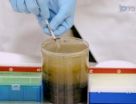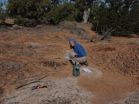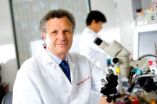(Press-News.org) CORVALLIS, Ore. – Electrical engineers at Oregon State University have developed new technology to monitor medical vital signs, with sophisticated sensors so small and cheap they could fit onto a bandage, be manufactured in high volumes and cost less than a quarter.
A patent is being processed for the monitoring system and it's now ready for clinical trials, researchers say. When commercialized, it could be used as a disposable electronic sensor, with many potential applications due to its powerful performance, small size, and low cost.
Heart monitoring is one obvious candidate, since the system could gather data on some components of an EKG, such as pulse rate and atrial fibrillation. Its ability to measure EEG brain signals could find use in nursing care for patients with dementia, and recordings of physical activity could improve weight loss programs. Measurements of perspiration and temperature could provide data on infection or disease onset.
And of course, if you can measure pulse rate and skin responses, why not a lie detector?
"Current technology allows you to measure these body signals using bulky, power-consuming, costly instruments," said Patrick Chiang, an associate professor in the OSU School of Electrical Engineering and Computer Science.
"What we've enabled is the integration of these large components onto a single microchip, achieving significant improvements in power consumption," Chiang said. "We can now make important biomedical measurements more portable, routine, convenient and affordable than ever before."
The much higher cost and larger size of conventional body data monitoring precludes many possible uses, Chiang said. Compared to other technologies, the new system-on-a-chip cuts the size, weight, power consumption and cost by about 10 times.
Some of the existing technologies that would compete with this system, such as pedometers currently in use to measure physical activity, cost $100 or more. The new electronics developed at OSU, by comparison, are about the size and thickness of a postage stamp, and could easily just be taped over the heart or at other body locations to measure vital signs.
Part of what enables this small size, Chiang said, is that the system doesn't have a battery. It harvests the sparse radio-frequency energy from a nearby device – in this case, a cell phone. The small smart phone carried by hundreds of millions of people around the world can now provide the energy for important biomedical monitoring at the same time.
"The entire field of wearable body monitors is pretty exciting," Chiang said. "By being able to dramatically reduce the size, weight and cost of these devices, it opens new possibilities in medical treatment, health care, disease prevention, weight management and other fields."
The new technology could be used in conjunction with cell phones or other radio-frequency devices within about 15 feet, but the underlying micropowered system-on-a-chip technology can be run by other energy-harvested power sources, such as body heat or physical movement.
OSU will work to develop this technology in collaboration with private industry, an increasing area of emphasis for the university. In the past two years, private financing of OSU research has increased by 42 percent, and the university has signed 108 research-based licenses of OSU technology.
###
This research was recently reported at the Custom Integrated Circuits Conference in San Jose, Calif. It has been supported by the National Science Foundation and the Catalyst Foundation.
Editor's Note: A digital image of the body monitoring chip is available online: http://bit.ly/UGxCmr
END
Magnetotactic bacteria, like Magnetospirillum magneticum, have evolved cellular processes that allow them to take up iron molecules to produce magnetic nanocrystals like magnetite. Since they were first discovered and isolated in 1975 by Robert Blakemore, scientists continue to be fascinated by these unique bacteria, whether as a means to isolate biogenic magnetite or to understand the evolutionary advantages of producing these minerals. A new video-article in JoVE (Journal of Visualized Experiments) details a procedure to purify and enrich samples of magnetotactic bacteria ...
Last March, researchers at UCLA reported the development of a molecular compound called CLR01 that prevented toxic proteins associated with Parkinson's disease from binding together and killing the brain's neurons.
Building on those findings, they have now turned their attention to Alzheimer's disease, which is thought to be caused by a similar toxic aggregation or clumping, but with different proteins, especially amyloid-beta and tau.
And what they've found is encouraging. Using the same compound, which they've dubbed a "molecular tweezer," in a living mouse model ...
PULLMAN, Wash.—Washington State University researchers have found an unlikely recipe for antibiotic resistant bacteria: Mix cow dung and soil, and add urine infused with metabolized antibiotic. The urine will kill off normal E. coli in the dung-soil mixture. But antibiotic-resistant E. coli will survive in the soil to recolonize in a cow's gut through pasture, forage or bedding.
"I was surprised at how well this works, but it was not a surprise that it could be happening," says Doug Call, a molecular epidemiologist in WSU's Paul G. Allen School for Global Animal Health. ...
What can high school and college-age video game enthusiasts teach young surgeons-in-training?
According to a new study from researchers at the University of Texas Medical Branch at Galveston (UTMB) – a world leader in minimally invasive and robotic surgery – the superior hand-eye coordination and hand skills gained from hours of repetitive joystick maneuvers mimic the abilities needed to perform today's most technologically-advanced robotic surgeries.
To offer insight on how best to train future surgeons, the study placed high school and college students head to head ...
Some arid lands in the American West degraded by military exercises that date back to General George Patton's Word War II maneuvers in the Mojave Desert should get a boost from an innovative research project led by the University of Colorado Boulder.
Headed up by CU-Boulder Assistant Professor Nichole Barger, the research team is focused on developing methods to restore biological soil crusts -- microbial communities primarily concentrated on soil surfaces critical to decreasing erosion and increasing water retention and soil fertility. Such biological soil crusts, known ...
By combining the power of the NASA/ESA Hubble Space Telescope, NASA's Spitzer Space Telescope and one of nature's zoom lenses, astronomers have found what is probably the most distant galaxy yet seen in the Universe. The object offers a peek back into a time when the Universe was only 3 percent of its present age of 13.7 billion years.
We see the newly discovered galaxy, named MACS0647-JD, as it was 420 million years after the Big Bang. Its light has travelled for 13.3 billion years to reach Earth, which corresponds to a redshift of approximately 11 [1].
This is the ...
An efficient, high-volume technique for testing potential drug treatments for Alzheimer's disease uncovered an organic compound that restored motor function and longevity to fruit flies with the disease, according to new research that could help put the search for an effective Alzheimer's drug on a faster track.
Princeton University researchers report in the Journal of Biological Chemistry that they discovered an organic compound that prevented the formation of protein clumps, or aggregates, found on human brain cells afflicted by Alzheimer's disease. The researchers ...
LA JOLLA, Calif., November 15, 2012 – Researchers and patients look forward to the day when stem cells might be used to replace dying brain cells in Alzheimer's disease and other neurodegenerative conditions. Scientists are currently able to make neurons and other brain cells from stem cells, but getting these neurons to properly function when transplanted to the host has proven to be more difficult. Now, researchers at Sanford-Burnham Medical Research Institute (Sanford-Burnham) have found a way to stimulate stem cell-derived neurons to direct cognitive function after ...
(Phoenix, AZ Nov. 15, 2012) -- Vision researchers at Barrow Neurological Institute have made a groundbreaking discovery into the optimization of light sources to human vision. By tuning lighting devices to work more efficiently with the human brain the researchers believe billions of dollars in energy costs could be saved.
The research was conducted by Stephen Macknik, PhD, of Barrow's Laboratory of Behavioral Neurophysiology, and Susana Martinez-Conde, PhD, of Barrow's Laboratory of Visual Neuroscience. The study is published Proceedings of the National Academy ...
Untreated depression is one of the leading causes of teen suicide, and signs of depression can also be a warning that a teen is contemplating suicide. In an article published this week in the quarterly journal, The Prevention Researcher, University of Cincinnati researchers are describing how positive connections can help offset these tragedies.
In the current issue, titled, "Teen Depression," UC researchers Keith King, a professor of health promotion, and Rebecca Vidourek, an assistant professor of health promotion, report that depression and suicide are "intricately ...




